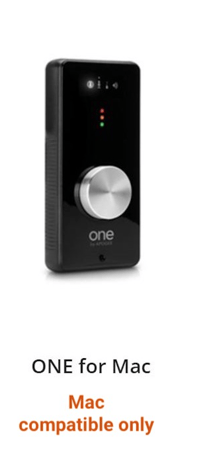Legacy One Guide for Intel and Apple Silicon Macs
Legacy One Guide for Intel and Apple Silicon Macs

One for Mac and One for iPad and Mac are compatible with Intel-powered and Apple Silicon (M1, M2, M3, etc.) Macs and Windows 10 and above.
For Apple Silicon Macs, this requires installing the Apogee Control 2 software which replaces the previous Apogee Maestro 2 app.
After installing, all settings will be adjusted in the Apogee Control 2 app.

Original One units are compatible with Intel-powered Macs up to Mac OS 10.15 and lower with the Apogee Maestro 2 driver.
For Original One there is no updated driver for this beyond MacOS 10.15.
As a result One will not be detected in the Maestro app (or Apogee Control 2 app) if installed on OS 11 and above.
One will work normally with Intel and Apple Silicon Macs without software installed. When connected One will automatically be detected in System preferences > Sound > Input and Output and you can select the input type here.
For example if wanting to use a condenser mic connected you'll select "One: Ext Mic 48v" in System Preferences > Sound > Input then this would apply in your DAW and you can use the main knob on One to adjust your input gain.
When you click down on One's knob this will cycle between your selected input and output control. When either icon on One is lit (Mic, instrument or speaker) you will be controlling the input gain or output volume.
One Firmware Versions:
You can check One's firmware when connected by opening System Information on your Mac. Under Hardware > USB > Select One and check what number this shows by Version.
This firmware version should be:
1.05 for for One for Mac ,and One for iPad and Mac
For Original One models no firmware applies.
If your One's firmware is outdated, you can update it using the One Firmware updater app included with the Apogee Maestro 2 installer. This process requires an Intel Mac, and we suggest performing the firmware update on macOS 10.15 Catalina or earlier for smooth operation.
All Apogee One USB drivers can be downloaded here under Legacy Product Installers
The current software and firmware versions are shown here
Direct Monitoring in Apogee Control 2
Enable direct monitoring by changing the Main/Headphone output to Mixer. 
When set as Mixer, the inputs and software playback are routed through the low-latency Mixer in Apogee Control 2 > then directly to One Output.
You can adjust the volume levels and settings in Mixer 1 for both the input and playback channels levels that are sending audio to the output.
Known changes with Apogee Control 2 compared to Maestro 2:
-No onscreen pop up indicators when adjusting volume and input gain
-Control 2 does not support Logic Device Control for adjusting input settings (48v, input types) from within Logic.
-Mac keyboard volume control not functional